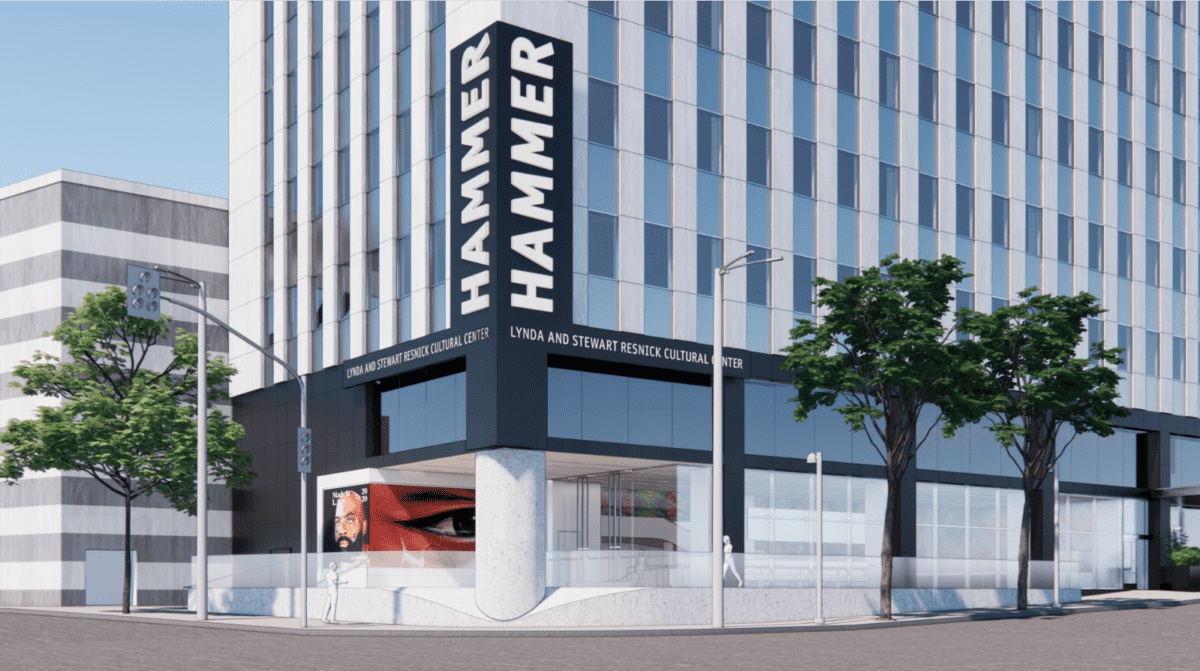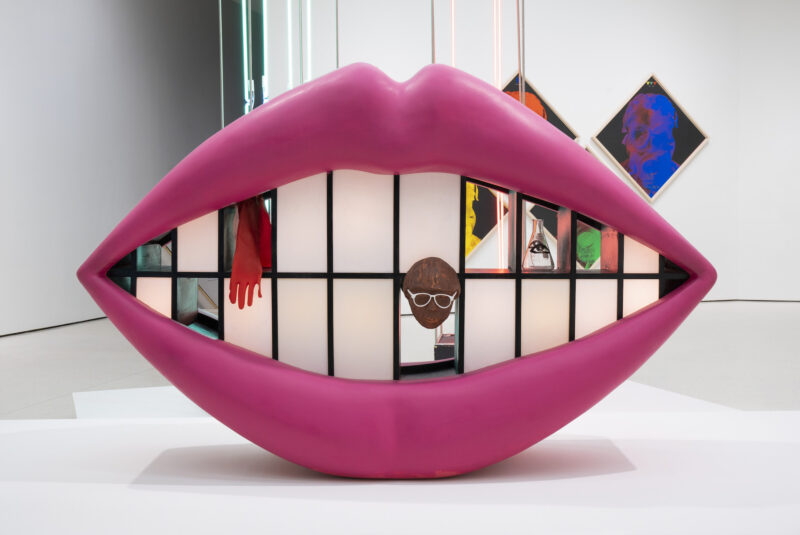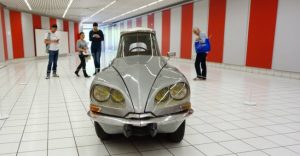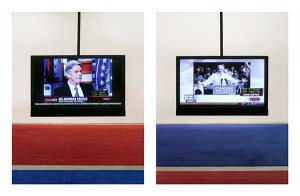UCLA Hammer Museum director Ann Philbin announced today that the institution’s two-decades-long project to remake itself inside and out—including expanding, renovating, and transforming the building—will reach its culmination on Sunday, March 26th, 2023. The public will be welcomed into the final major architectural components of the project, designed by Michael Maltzan Architecture, and an exciting new group of exhibitions celebrating the Hammer’s collection of contemporary art. As always, the museum offers free admission to its exhibitions and programs.

The new building, the Lynda and Stewart Resnick Cultural Center, anchors the Hammer’s overall transformation. The center honors co-owners of The Wonderful Company, global philanthropists Lynda and Stewart Resnick, and their longstanding commitment and impact on arts and culture in Los Angeles and across California.
The Lynda and Stewart Resnick Cultural Center welcomes visitors to freely explore through a new street-level entrance located prominently at the corner of Wilshire and Westwood boulevards. The naming of the building recognizes the Resnicks’ gift, through their foundation, of $30 million—the largest single gift in the Hammer’s history—announced in 2018. The Resnicks have a long-standing commitment to philanthropy, with similarly historic gifts to institutions including UCLA, LACMA, and Caltech, as well as efforts in California’s Central Valley where they support work in community engagement, health and wellness, and education.
Art is a platform for ideas and creative expression that immeasurably benefits humanity, and today that’s more important than ever
said Lynda Resnick, co-owner of The Wonderful Company.
Stewart and I are proud of our long association with the Hammer and delighted to be part of this next evolution. For generations, the Hammer has championed the art and artists who challenge us to see the world in a new light and experience the unexpected. We’re thrilled this new space will continue to be part of the Los Angeles landscape and contribute to building a better world in which art is available to everyone.
With a much greater street presence and a location directly across from the future L.A. Metro Purple Line, the new entrance boldly announces the Hammer at the gateway to Westwood Village and UCLA. The spacious new lobby incorporates regularly changing installations of artworks and creates a more welcoming environment for museum visitors. The March opening will also see the debut of a newly annexed gallery space and outdoor sculpture courtyard on the corner of Wilshire and Glendon.
The new lobby will debut with a dramatic, densely configured installation by Japanese artist Chiharu Shiota, while the new street-level gallery will feature Rita McBride’s Particulates, part of the Hammer’s permanent collection. Sanford Biggers’s 25-foot-tall cast bronze sculpture Oracle, previously installed in New York’s Rockefeller Center, will occupy the new sculpture terrace. Most importantly, nearly all of the Hammer’s galleries will be filled with an unprecedented display of works from its contemporary art collection, in addition to a retrospective of drawings by British artist Bridget Riley.
While Maltzan has worked with the Hammer since 2000, the museum’s transformation kicked into high gear in 2015 when UCLA acquired the adjoining office tower, designed by Claud Beelman in 1962, which allowed the Hammer to inhabit two additional floors and thereby expand its facilities for greater public access. Since 2015 the Hammer has fully renovated its existing galleries, public event spaces and restaurant; expanded its offices and other back-of-house spaces; added a brand-new gallery and study center for works on paper; and, most recently, renovated the singular Hammer Store. In total, the Hammer has grown by 40,000 square feet, while achieving its goals of:
- creating a dramatic presence across a full city block
- increasing gallery space by 60 percent
- providing 20,000 square feet of renovated and enhanced community space
- showcasing its permanent collection—including the Grunwald Collection of more than 45,000 works on paper and the Hammer Contemporary Collection of more than 4,000 objects—while at the same time presenting its renowned temporary exhibitions.
Ann Philbin said,
When we began collaborating with Michael Maltzan more than 20 years ago, he was an ‘emerging’ architect, so it has been a joy to work together and see him gain international acclaim for his work. From the start, our goal was to make the Hammer into a welcoming, public-facing, university-affiliated institution engaged with today’s art and artists and the urgent issues of our time. With the unflagging support of our visionary Board of Trustees chaired by Marcy Carsey, and generous donors, especially Lynda and Stewart Resnick, the UCLA community, brilliant staff, and Michael Maltzan’s design wizardry, we succeeded in quadrupling attendance over those years, and have become a beloved institution to our audience and especially the artists of this city. I am beyond thrilled to welcome everyone to a reimagined Hammer Museum that is more than twenty years in the making.
Outside and Inside the Transformed Hammer
The Hammer’s transformation began with a period of institutional and architectural change focused on expanding the museum’s program and opening the original museum building designed by Edward Larrabee Barnes, taking advantage of the potential for indoor-outdoor space, and creating the Billy Wilder Theater in 2006 as a center for film and other public programs. In 2012 the central courtyard (now known as the Pritzker Family Commons) was transformed into a beautiful and lively gathering place; and in 2015 the now-iconic John V. Tunney Bridge connected the third-floor galleries.
The master plan gained momentum in 2015 with the Hammer’s signing of a 99-year lease with UCLA for 40,000 additional square feet in the former Oxy Tower, adjacent to the existing museum building, which led to the creation of the Bay-Nimoy Studio (2018), Annenberg Terrace, a reimagined entrance on the museum’s Lindbrook Drive side, and a renovated restaurant (all 2019); the expansion and renovation of back-of-house administration (2021); and the addition of a new works on paper gallery and study center as well as the renovated Hammer Store (2022).
The project culminates in 2023 with the creation of the prominent, street-level main entrance for the museum. A cylindrical, one-story-high column set into a concave fold in the pavement marks the busy corner of Wilshire and Westwood, directly across from the future site of the Metro Purple Line station. The column supports the edge of a porch that has been carved out of the tower to provide dramatic and welcoming point of entry. On one inner side of the entrance is a video wall for projecting artworks and information; on the other is the entry to the lobby. Above the entryway is a new, large white-on-black sign rising a full five floors of the museum building, boldly identifying the Hammer Museum and the newly named Lynda and Stewart Resnick Cultural Center.
As the museum now stretches the length of the entire city block, a similar vertical sign for the Hammer adorns the corner of Glendon and Wilshire, newly defined by a 900-square-foot sculpture terrace. Inaugurating the sculpture pedestal at the time of the March 2023 opening will be Oracle by Sanford Biggers (2021), a cast bronze, 25-foot-tall figure from the artist’s “Chimera” series, co-presented by the Art Production Fund.
Inside the Wilshire and Glendon corner of the tower, in a new 5,600-square-foot gallery, will be a monumental yet ethereal installation by Rita McBride, Particulates (2021), a gift from Brenda R. Potter to the Hammer Contemporary Collection, whose play of high-intensity lasers and mist will be visible from the street at night through the expanse of glass the architects have created along Wilshire Boulevard. At a future date the Hammer will enhance and directly connect this new gallery at the corner of Wilshire and Glendon to the redesigned museum lobby, creating a highly visible, block-long space for the display of large-scale artworks.
The highly transparent façade running along the first floor will also open views into the spacious new lobby on the Westwood side of the tower. Inside the lobby, regularly changing installations of wall-size artworks will create what Michael Maltzan considers to be the building’s “true façade.” The first of these installations will be a new work by Chiharu Shiota. Ramps, stairs, and a passenger elevator organized around a striking, elliptical information desk will lead visitors to the exhibition galleries.
Just as the museum’s facilities have transformed over the last two decades, so too has its collection. Occupying five galleries—nearly all the Hammer’s exhibition space—will be the largest presentation in the museum’s history of the Hammer Contemporary Collection. Highlighting acquisitions made since 2005, when the Hammer began to collect contemporary art, the installation will feature works in all media by artists including John Baldessari, Zheng Bo, Amoako Boafo, Lee Bontecou, Mark Bradford, Huguette Caland, Tony Cokes, Njideka Akunyili Crosby, Karon Davis, Kenturah Davis, Jimmie Durham, Christina Fernandez, Owen Fu, Charles Gaines, Robert Gober, Lauren Halsey, Eva Hesse, Tishan Hsu, Luchita Hurtado, Mike Kelley, Paul McCarthy, Laura Owens, Roland Reiss, Deborah Roberts, Allen Ruppersberg, Kaari Upson, Kara Walker, Akram Zaatari, and many others.
To date, the Resnicks have invested more than $2.3 billion in philanthropy, with more than $1.3 billion invested in environmental sustainability, to help combat climate change and preserve the planet for future generations. The Resnicks’ groundbreaking philanthropic efforts include the recent $750 million pledge to Caltech, the largest in the Institute’s history and among the largest ever for environmental sustainability research. Additionally, the Resnicks pledged $50 million to The University of California, Davis, in October to support the school’s longstanding commitment to addressing agriculture and environmental sustainability challenges.






